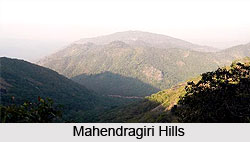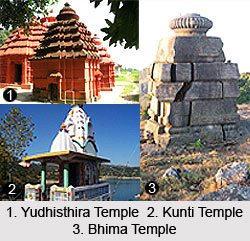 Mahendragiri hill is situated in the middle of Eastern Ghats in the Gajapati district which is 175 km from Berhampur. Though the major part of this hill range now comes under Andhra Pradesh, the 4,943 feet high peak Mahendragiri is actually located within the district of Gajapati. The hills lies exposed to the sea-breeze. The river Mahendratanaya flows down the mountain in the east through Mandasa and joins the Bay of Bengal at Barua which was once an important ancient port. Saoras are the main tribe in these hill forests, but they come under vulnerable tribal group.
Mahendragiri hill is situated in the middle of Eastern Ghats in the Gajapati district which is 175 km from Berhampur. Though the major part of this hill range now comes under Andhra Pradesh, the 4,943 feet high peak Mahendragiri is actually located within the district of Gajapati. The hills lies exposed to the sea-breeze. The river Mahendratanaya flows down the mountain in the east through Mandasa and joins the Bay of Bengal at Barua which was once an important ancient port. Saoras are the main tribe in these hill forests, but they come under vulnerable tribal group.
History of Mahendragiri Hill
Mahendragiri is foremost of the seven "Kulagiris" or principal mountains of India. It is associated with mythological stories from the Ramayana as Mahendra Parvata. It is also known as the Southern Amarnath of Odisha. It is a "Kula Parvata" along with Malaya, Sahyadri, Parijatra, Shuktiman, Vindhya and Malyavaan. In the Puranas and Mahabharata that Parashuram practiced penance for a long time on the Mahendra Mountain. Archaeological remains at Mahendragiri make an interesting study for the scholars. Shiva Ratri is the main festival here which draws a large crowd. This testifies the fact that it was once a centre of Saivite culture. The place is visited by about 1,600 tourists annually.
Flora and Fauna of Mahendragiri Hill
The surrounding forests abound in peacocks, flying squirrels, elephants, spotted deer and even leopards and talking mynahs. The view of the surrounding area from the top of the hill is enchanting. The range of granite hills on the north-west and south succeed one another like huge waves and the passage of clouds from peak to peak produces an ever-changing scene. The clear waters of the sacred Mahendratanaya, the blue sea at a distance and the mountain with its majestic beauty make Mahendragiri a trekker`s dream come true.
 Mahendragiri is full with biodiversity, species from the Himalayas, Western Ghats and the Nilgiris of south India being found here. The hill has a very rich and varied biodiversity, including 642 species of flowering plants, of which 37 species are orchids, 58 species of flowerless plants and 5 species of lichens among various other species. The kind of lichens found here are not found in the Eastern Ghats and are important from both ecological and medicinal points of view. At least 300 medicinal plants are available in the Mahendragiri ecosystem.
Mahendragiri is full with biodiversity, species from the Himalayas, Western Ghats and the Nilgiris of south India being found here. The hill has a very rich and varied biodiversity, including 642 species of flowering plants, of which 37 species are orchids, 58 species of flowerless plants and 5 species of lichens among various other species. The kind of lichens found here are not found in the Eastern Ghats and are important from both ecological and medicinal points of view. At least 300 medicinal plants are available in the Mahendragiri ecosystem.
Temples on Mahendragiri Hill
There are 3 temples on the top of the mountain. These temples are named after the Pandava brothers and their mother Kunti who visited Mahendragiri during the period of their exile.
•Kunti temple is 30 feet high and is at one end of the flat top the mountain. Some sculptures and dressed stone slabs are lying scattered around the temple.
•Yudhisthira temple rising abruptly from the ground level is on the other side of the flat top of the mountain. The outer walls are devoid of any sculptural decoration excepting four Chaitya arches.
•Bhima temple, assumed by scholar to have been built just after the Gupta period, appears to be the earliest of these temples. There is no sculptural decoration worth mentioning. This temple is often regarded as the "Gokarnesvara Temple" of the place.
Shiv Ratri Celebration at Mahendragiri Hill
Shiv Ratri is celebrated with pomp, devotion and merriment in Gajapati. The administration had made several arrangements for a safe and smooth celebration of Shiv Ratri on the Mahendragiri Hills. Thousand of devotees from around the world travels here and trek onto the peak to worship Lord Shiva on that day and enjoys the tranquil and striking expressions of nature. Early in the morning the "Surya Uday" (sunrise) was the major attraction for the devotees.
Tourism in Mahendragiri Hill
It is not only a religious place, also a famous tourist place in eastern Odisha. Large number of tourist visits the hill and goes for trekking. The tourists trek on the peak to visit the three temples dedicated to the Pandavas. According to the trekkers, Mahendragiri Hill is quite difficult to climb.















